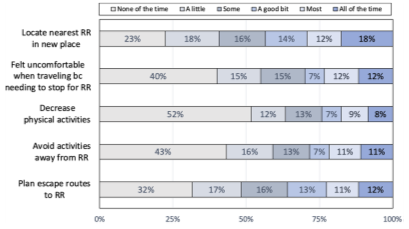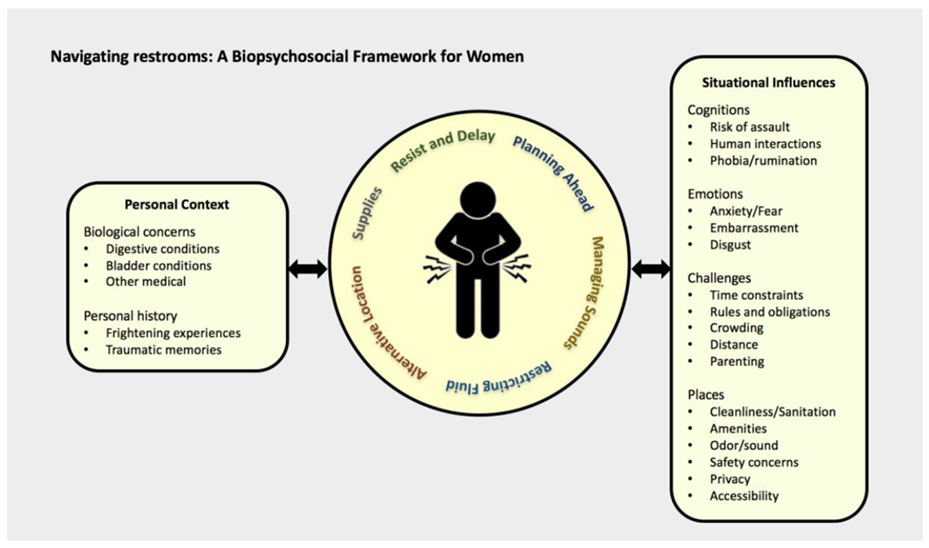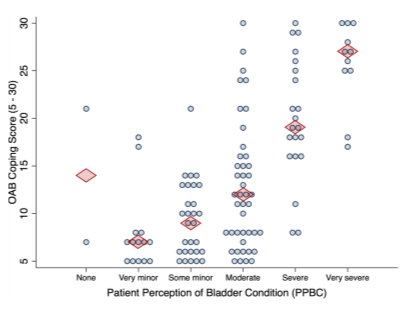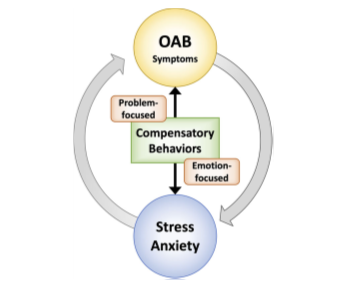Bladder health and behaviors
This research area focuses on bladder and urinary health, including bladder behaviors and strategies that individuals use to cope with their urinary conditions and situations and knowledge about pelvic floor disorders. This research also examines how an individual’s broader social ecology both impacts on urinary symptoms and, in turn, is impacted by urinary symptoms.

Figure 2. Proportion of women who avoid public restrooms and reasons why. From Reynolds et al, The Journal of Urology, 2020.
FIGURE 2: OAB Coping Scores according to OAB severity (measured by PPBC). Red diamonds represent median values. From Reynolds et al, Neurourology and Urodynamics, 2021.
FIGURE 3: Conceptual model. OAB symptoms and emotional states (i.e., stress and anxiety) interact in a feed‐forward, cyclical relationship (gray arrows). Compensatory behaviors can modulate this relationship (black arrows) by decreasing OAB symptoms (i.e., problem‐focused coping behaviors) or by alleviating emotional responses (i.e., emotion‐focused coping behaviors). Reduced emotional distress then reinforces the compensatory behaviors, making them more likely to occur again in the future. From Reynolds et al, Neurourology and Urodynamics, 2021.

Figure 1. A biopsychosocial framework for women navigating restrooms. From Hartigan et al, International Journal of Environmental Research and Public Health, 2020.
Selected Publications
Kowalik CG, Cohn J, Delpe S, Wein AJ, Kaufman MR, Dmochowski RR, Reynolds WS. (2018). Painful bladder symptoms related to somatic syndromes in a convenience sample of community women with overactive bladder symptoms. Journal of Urology; 201(1):129-134. PMID: 30017963. PMCID: PMC6298830.
Daily A, Kowalik CG, Delpe S, Kaufman MR, Dmochowski RR, Reynolds WS (2019). Women with overactive bladder exhibit more unhealthy toileting behaviors: a cross-sectional study. Urology; 134:97-102. PMID: 31499079 PMCID: PMC6924631
Suskind AM, Kowalik C, Quanstrom K, Boscardin J, Zhao S, Reynolds WS, Mishra K, Finlayson E (2019). The Impact of Frailty on Treatment for Overactive Bladder in Older Adults. Neurourology and Urodynamics. [Epub 2019 Jul 8] PMID: 31286561
Goodridge SD, Chisholm LP, Heft J, Hartigan S, Kaufman M, Dmochowski RR, Stewart T, Reynolds WS (2019). Association of knowledge and presence of pelvic floor disorders and participation in pelvic floor exercises: A cross sectional study. Female Pelvic Medicine and Reconstructive Surgery. [Epub January 25, 2020]. PMID: 32217913
Kowalik CG, Daily A, Goodridge SD, Kaufman MR, Fowke JH, Dmochowski RR, Reynolds WS (2020). Factors associated with urinary incontinence in a community sample of young, nulligravid women. Neurourology and Urodynamics; 39(5):1430-1436. PMID: 32324941, PMCID: PMC7321803
Hartigan S, Bonnet K, Chisholm L, Kowalik C, Dmochowski RR, Schlundt D, Reynolds WS (2020). Why do women not use the bathroom? Women’s attitudes and beliefs on using public restrooms. International Journal of Environmental Research and Public Health; 17(6): 2053. [Epub March 20, 2020]. PMID: 32244871, PMCID: PMC7142493.
Reynolds WS, Kaufman MR, Bruehl S, Dmochowski RR, McKernan LC (2021). Compensatory Bladder Behaviors (“Coping”) in Women with Overactive Bladder. Neurourology and Urodynamics. [Epub September 15, 2021]. PMID: 34524704. PMCID: in process.


